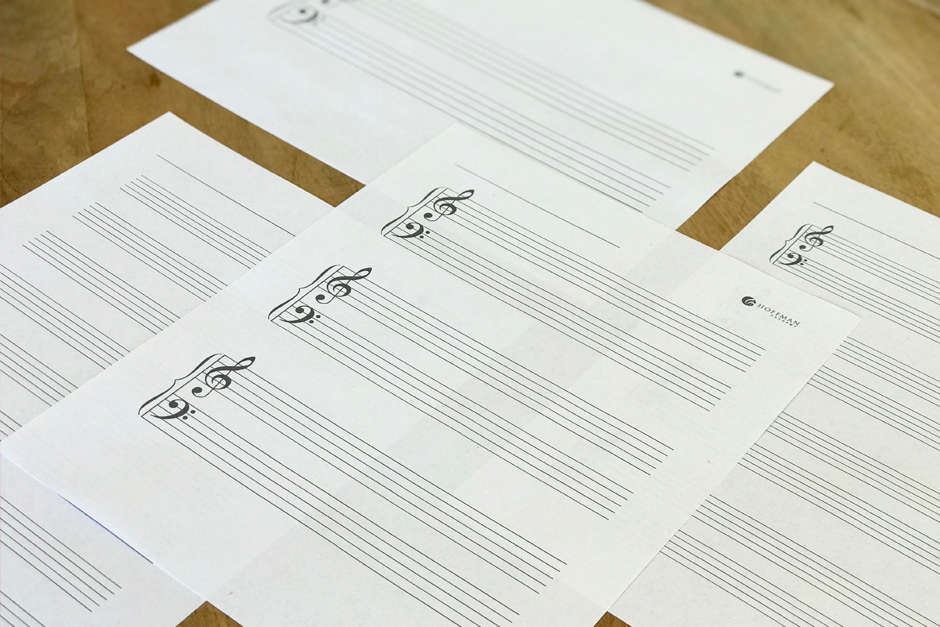Blank Staff Paper for All Levels
Use this blank staff paper (also known as “manuscript paper”) for dictation exercises and for your original compositions. “Extra large” means the staff is large for beginning composers, with fewer staffs per page.
Ready to compose your own song? Check out this post and use our blank staff paper!
Subscribe for updates, content & free resources!
Where did staff paper come from? A brief history of the staff
Here’s a true story of how the first staff was invented, in case you want to learn about the grand staff before using your free printable staff paper.
About a thousand years ago there were men called monks who lived together in a monastery. These monks were religious people. They read the Bible, and they got together every three hours to sing and to pray. The monks knew hundreds of different songs which we call “chants”. In fact, they knew so many chants that it became hard to remember them all. They invented a way to draw the notes so they could remember and easily share with others the hundreds of chants that they knew. The system they invented is still in use today and it’s what we use to draw music.
You might be interested to know that when it was first invented a thousand years ago, the staff only had four lines, but today we use a five-line staff. Originally, notes were drawn with square and rectangle shapes but today we use a round shape called the note head.
The monks decided that if the song had a low note they would draw it down low on the staff and the higher the position of the note the higher you would sing. They also decided that notes could be on a line or on a space between the lines. As notes step up they go line, space, line, space, line. Take a look at the video below to see this all more clearly.
Want to learn piano? We can help! Sign up for a free account now.
Meet the grand staff
You’ll notice that the grand staff has two staves, which is the plural of staff. That’s because when playing piano music we need a staff for your left hand and a staff for your right hand. When you put those two staves together it makes the grand staff.
You probably also noticed that there are some new symbols on the staff in the video. The top symbol is for the treble clef. Treble means “high”, so the treble clef is used when drawing any notes from this middle C all the way up to the highest notes.
This treble clef is a symbol to remind you of something. Notice how there is a hidden G shape in the treble clef? Sometimes the treble clef is called the G clef and that’s because it’s an old, fancy way of drawing the letter G. In music it became tradition to draw this G clef to remind you that the line going through the G swirl is the line for the note G. Anytime you see a note head on that G line, we call that note “treble G” on the piano.
If the note head moves off the G line up to the next space, then it becomes a different note that is one step higher. The note that’s one step above G is A. If we go from the A space up to the next line, we’re now on a B. This pattern continues through the entire staff.
Staff paper and ledger lines
If we want to keep going higher above the staff, then we’ll need a special line called a ledger line. Ledger lines help us go off the staff, above or below. If you want to keep going past the top staff line, which is G, we could go one higher up to A and keep on going as high as we want.
The bass clef on staff paper
Now let’s take a look at this other clef. This clef is for the low notes, including every note below middle C on the piano and all the way down.
We call this staff the bass clef and its nickname is the F clef. The F clef is also an old-fashioned way to draw the letter “F”. We call it an F clef because it shows us where the F line is. Anytime a note head is on this line, we call that note bass F.
Middle C on staff paper
Now there’s one more note to learn today. This note forms a kind of bridge between the treble staff and the bass staff and it’s positioned on a ledger line which, remember, helps us to draw notes that go off the edge of the staff.
This note is one ledger line below the treble staff or one ledger line above the bass staff and we call it middle C. Middle C is the C nearest the middle of your piano. As a review, try pointing to and naming all three of the notes that we learned today: Treble G, middle C, bass F.
We hope you now feel more comfortable with staff paper. Don’t forget to download your free, printable blank staff paper for more practice! We have small, medium, and large sizes available, plus single staff and grand staff options.




